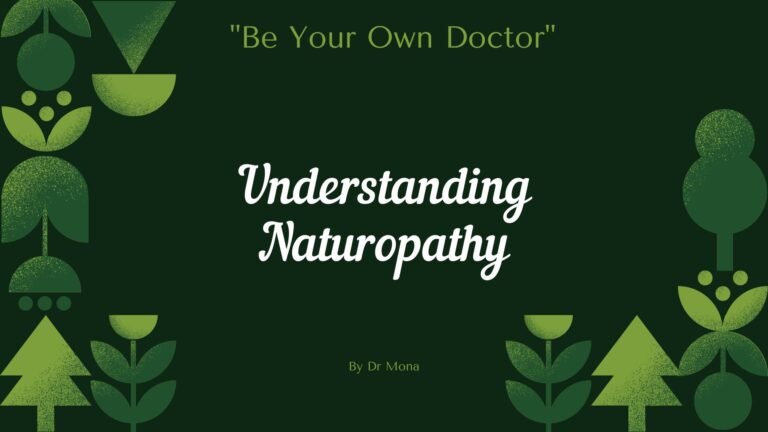Introduction to Naturopathy & General Physical Examination
Introduction to Naturopathy & General Physical Examination

Naturopathy is a holistic approach to healthcare that focuses on treating the patient as a whole rather than just addressing symptoms. It emphasizes natural healing methods and the prevention of diseases through lifestyle modifications and natural remedies.
The Core Principles of Naturopathy:
- Blending Tradition with Modern Science: Naturopathy integrates age-old healing traditions with modern scientific discoveries and research. It combines various natural therapies, including herbal medicine, nutrition, yoga, and hydrotherapy, to promote overall well-being.
- Prioritizing Disease Prevention: A key principle of naturopathy is preventing diseases before they occur. By making conscious lifestyle choices, maintaining a balanced diet, and managing stress effectively, individuals can reduce the risk of developing chronic illnesses.
- Acknowledging the Body’s Natural Healing Capacity: The human body has an inherent ability to heal itself. Naturopathy supports this process by providing natural therapies that enhance the body’s self-repair mechanisms. It encourages detoxification, strengthens immunity, and restores balance.
- Encouraging Personal Responsibility for Health: Naturopathy promotes self-awareness and accountability in maintaining health. Individuals are empowered to make informed decisions about their well-being by adopting healthy habits, understanding their body’s needs, and seeking natural solutions to health challenges.
Naturopathy is a patient-centered approach that focuses on long-term health benefits rather than quick fixes. By blending traditional wisdom with modern science, emphasizing prevention, and harnessing the body’s natural healing power, it provides a sustainable path to achieving optimal health naturally.
A Holistic Approach to Healing:
The goal of naturopathic medicine is to treat the whole person—mind, body, and spirit—rather than focusing on isolated symptoms. This approach ensures that all aspects of an individual’s well-being are considered in the healing process.
Naturopathy seeks to address the root causes of illnesses rather than merely suppressing symptoms. By identifying underlying imbalances, practitioners can develop personalized treatment plans that promote long-term health and disease prevention.
Unlike conventional medicine, which often relies on cause-and-effect relationships, naturopathy is based on the principle of complexity. It acknowledges that a patient’s health may result from multiple interacting factors, including genetics, environment, lifestyle, and emotional well-being.
Furthermore, naturopathy treats all aspects of health—physical, mental, social, and spiritual—simultaneously. By addressing these interconnected elements, it provides a comprehensive approach to healing and overall wellness.
What is Naturopathy? A Comprehensive Natural Healing System
Naturopathy is a holistic approach to health and wellness that focuses on the body’s innate ability to heal itself. This natural healing system integrates traditional wisdom with modern scientific knowledge, offering a non-invasive and patient-centered form of care.
Definition of Naturopathy:
Naturopathy is defined as a healing system that:
- Emphasizes natural remedies and therapies to support overall well-being.
- Treats the whole person rather than just addressing isolated symptoms.
- Encourages self-healing by stimulating the body’s inherent mechanisms.
- Uses non-invasive methods such as nutrition, herbal medicine, physical therapy, and lifestyle modifications.
- Combines ancient healing traditions with modern scientific research to create an effective and holistic approach to health.
Naturopathy operates on the fundamental belief that the human body has an inherent ability to maintain and restore health when provided with the right conditions. By addressing the root cause of health concerns rather than simply suppressing symptoms, naturopathy promotes long-term well-being.
Core Philosophy:
Naturopathy is based on fundamental beliefs that guide its approach to health and healing. These core philosophies include:
- The Body’s Innate Healing Abilities: Naturopathy acknowledges that the human body possesses an inherent capacity for self-healing. The goal of naturopathic treatment is to enhance and support this natural ability rather than interfere with it.
- Disease as a Result of Imbalance: Instead of viewing diseases as isolated problems, naturopathy considers illness as a manifestation of an internal imbalance. By restoring equilibrium through natural means, health can be regained and maintained.
- Prevention is better than Cure: Naturopathy places great emphasis on preventive healthcare. By adopting healthy habits, managing stress, and making informed lifestyle choices, individuals can prevent diseases before they arise.
- Addressing Root Causes: Unlike conventional medicine, which often focuses on symptom relief, naturopathy seeks to identify and treat the underlying causes of health conditions. This leads to long-term wellness rather than temporary fixes.
- Nature Provides Healing Solutions: Naturopathy harnesses the power of nature to restore health. By utilizing plant-based medicine, nutritional therapies, and lifestyle interventions, it offers gentle yet effective solutions for healing.
The Naturopathic Consultation Process:
A naturopathic doctor takes a comprehensive approach to diagnosis and treatment. Unlike conventional medical consultations, which may be brief, a naturopathic evaluation typically lasts between one to two hours. During this time, the practitioner gathers detailed information about the patient’s overall health.
The consultation involves discussing various aspects of the patient’s well-being, including their health history, stress levels, and lifestyle habits. These factors play a crucial role in understanding the root causes of any existing health issues. Additionally, naturopathic doctors may recommend specific laboratory tests to gain deeper insights into the patient’s health status and create a tailored treatment plan.
General Physical Examination
A naturopathic examination takes a holistic approach, incorporating various assessment methods to gain a comprehensive understanding of the patient’s health. This process involves three key components: a detailed health history, a physical examination, and specialized diagnostic techniques.
- Health History: A naturopath begins by gathering an extensive medical history, including the patient’s personal and family health background. This also includes an in-depth discussion about diet, lifestyle habits, environmental exposures, and emotional well-being. Additionally, a naturopath reviews any current medications, supplements, or natural health products the patient is taking to assess their overall impact on health.

2. Physical Examination: The physical exam in naturopathy extends beyond conventional medical check-ups. It includes an evaluation of the patient’s body size, shape, mobility, gait, and posture. Observing these aspects helps the practitioner identify potential imbalances, postural misalignments, or physical stressors affecting overall health.
3. Other Diagnostic Techniques: Naturopathic practitioners may employ additional diagnostic tools to gain deeper insights into a patient’s health. These techniques may include:
- Kinesiology – A muscle-testing method used to assess imbalances in the body.
- Iridology – The study of the iris to determine systemic health conditions.
- Blood, Stool, and Urine Analysis – Laboratory tests that help evaluate organ function, detect nutrient deficiencies, and identify toxins.
- Hair Analysis – A diagnostic test to assess mineral levels and heavy metal toxicity.
- Functional Testing – Advanced assessments to detect biochemical imbalances and metabolic dysfunctions.
4. Therapeutic Encounter: A crucial aspect of naturopathic assessment is understanding the patient’s life beyond just physical symptoms. A naturopath listens to the patient’s story to gain insights into how their health concerns impact their daily life. This includes evaluating social relationships, emotional stressors, and thought patterns, all of which play a significant role in overall well-being.
5. Treatment Plan: Based on the comprehensive evaluation, a naturopath develops an individualized treatment plan tailored to the patient’s unique needs. This plan considers all aspects of the patient’s life, ensuring a holistic approach to healing. Naturopathic medicine is designed to complement modern medical practices, integrating both conventional diagnostic skills and natural therapies. Practitioners assess contributing factors such as lifestyle, habits, attitudes, and constitutional tendencies to create a well-rounded strategy for optimal health and well-being.
By combining these assessment methods, naturopathy ensures a thorough understanding of the patient’s health, enabling practitioners to create personalized treatment plans that focus on restoring balance and promoting natural healing.
Basic Concept of Naturopathy:
The core concepts of naturopathy revolve around the body’s natural ability to heal and maintain balance. These include:
- Accumulation of morbid matter: Toxins and waste products accumulate in the body, leading to disease and dysfunction.
- Abnormal composition of blood and lymph: The quality of blood and lymph directly impacts health, and any imbalance can contribute to illness.
- Lowered vitality: A decline in the body’s vital energy weakens its ability to fight disease and recover from ailments.
- Enervation: A state of exhaustion or nervous depletion that reduces the body’s ability to function optimally.
These fundamental principles emphasize the importance of detoxification, proper nutrition, and lifestyle adjustments to restore balance and support the body’s innate healing processes.
Disease in Naturopathy is Imbalance:
In naturopathy, disease is viewed as an imbalance within the body rather than a singular ailment. All diseases, their causes, and their treatments stem from one underlying issue: the accumulation of morbid (waste) materials and bodily refuse in the system. This toxic buildup disrupts the body’s equilibrium and leads to illness.
The only way to cure disease is to facilitate the body’s ability to eliminate these accumulated toxins. Naturopathic treatment focuses on employing natural methods that help the system cleanse itself, thereby restoring health and vitality. By addressing the root cause rather than merely suppressing symptoms, naturopathy ensures long-term well-being and disease prevention.
The Holistic Approach of Nature Cure
Nature cure does not believe in a specific cause of disease or a one-size-fits-all treatment approach. Instead, it considers all the factors responsible for disease, including:
- Unnatural habits: Irregularities in living, thinking, working, sleeping, relaxation, and sexual indulgence can disturb the body’s natural balance.
- Environmental factors: External influences such as pollution, diet, and lifestyle choices also contribute to disease.
These disturbances lead to the body becoming morbid, weak, and toxic, reducing its natural ability to function effectively. Naturopathy aims to restore harmony by addressing these underlying factors, promoting balance, and enhancing the body’s self-healing ability.
Basic Principles of Naturopathy:
Naturopathy is based on core principles that guide its approach to health and healing:
- The Body Heals Itself: The human body has an inherent ability to restore and maintain health if given the right conditions.
- Lower Vitality is the Root Cause of Disease: Disease arises from a weakened state of vitality, often due to poor lifestyle habits.
- Accumulation of Morbid Matter: Toxins and waste products build up in the body, further reducing vitality and contributing to illness.
- Acute Disease is a Natural Remedy: Acute conditions like fever, inflammation, and detoxification processes are the body’s natural ways of restoring balance and eliminating harmful substances.
- Germs Do Not Cause Disease: Germs are found in diseased conditions, but they are not the primary cause of illness. Instead, disease results from internal imbalances and toxic accumulation.
- Fasting Does Not Cure Disease but Creates the Right Environment for Healing: Fasting helps the body detoxify and initiate self-healing mechanisms.
- Exercise and Physical Activity Maintain Balance: A combination of nutrition and drainage is essential for health, and physical activity plays a crucial role in this balance.
- External Treatments Facilitate Healing: Various natural therapies support the body’s ability to recover and rejuvenate.
- Patient’s Determination and Faith in Natural Healing Play a Key Role: The desire to get well, combined with trust in nature’s healing power, significantly enhances the healing process.
By understanding and implementing these principles, naturopathy offers a holistic and natural approach to health, focusing on long-term wellness rather than temporary relief from symptoms.
Understanding the Fundamental Concepts:
1. The Body Heals Itself:
The human body possesses an innate intelligence and self-healing mechanism. Every cell in our body has the natural ability to repair, regenerate, and restore itself, provided the right conditions are met.
This natural ability is evident in various everyday processes, such as:
- Wound healing without external intervention, where the body forms a scab to protect the area and regenerates new tissue.
- Fever as a natural defense mechanism, which helps eliminate harmful pathogens and restore balance within the body.
- Bone knitting itself after a fracture, demonstrating the body’s remarkable capability to mend damaged structures.
- The immune system fighting off infections, which showcases the body’s ability to combat foreign invaders and maintain overall health.
Role of a Naturopath:
A naturopath plays a crucial role in supporting and enhancing the body’s inherent healing processes. Rather than suppressing symptoms, they aim to:
- Remove obstacles to healing by addressing factors that hinder recovery, such as poor diet, stress, or environmental toxins.
- Create optimal conditions for natural healing through lifestyle modifications, nutrition, detoxification, and holistic therapies.
- Support the body’s inherent healing processes by using natural remedies, physical therapies, and personalized treatment plans to restore balance and vitality.
By embracing the principles of naturopathy, individuals can cultivate a healthier lifestyle that aligns with the body’s natural rhythms, fostering long-term well-being and resilience against disease.
2. Lower Vitality / Enervation as Disease Origin:
Vitality refers to the body’s life force or energy reserves, which are essential for maintaining health and overall well-being. When vitality is compromised, the body’s ability to heal, detoxify, and function optimally diminishes. This state of reduced energy is known as enervation.
Causes of Lowered Vitality:
Several factors contribute to a decline in vitality, including:
- Physical and mental overwork, which depletes energy reserves and leads to exhaustion.
- Lack of proper rest and sleep, preventing the body from undergoing essential repair and recovery processes.
- Poor dietary habits, such as consuming processed foods, excessive sugars, and unhealthy fats that burden the body’s systems.
- Environmental toxins, including pollutants, chemicals, and artificial substances that disrupt physiological balance.
- Chronic stress, which weakens the nervous system and depletes the body’s ability to cope with daily challenges.
Impact of Lowered Vitality:
When vitality declines, it has far-reaching consequences on health, including:
- Reduced immune function, making the body more vulnerable to infections and diseases.
- Decreased digestive efficiency, leading to poor nutrient absorption and gastrointestinal issues.
- Impaired elimination, resulting in toxin buildup and contributing to chronic health conditions.
- Slower healing response, as the body’s ability to repair and regenerate is compromised.
- Increased susceptibility to illness, as weakened vitality disrupts the body’s natural defense mechanisms.
By identifying and addressing the root causes of lowered vitality, naturopathy helps restore energy balance and overall health. Through natural therapies, lifestyle modifications, and holistic treatments, individuals can regain their vitality and enhance their body’s ability to heal and thrive.
3. Accumulation of Morbid Matter:
Morbid matter refers to toxic substances that accumulate in the body, leading to an imbalance in health. These substances disrupt normal physiological functions and contribute to disease.
Sources of Morbid Matter:
The accumulation of morbid matter can result from various sources, including:
- Undigested food particles, which lead to fermentation and toxin buildup in the digestive system.
- Metabolic waste products, generated by cellular activities, which must be efficiently eliminated.
- Environmental toxins, such as air pollutants, pesticides, and heavy metals that enter the body through food, water, and air.
- Chemical residues, found in processed foods, medications, and household products, which burden the body’s detoxification systems.
- Emotional toxins, such as stress, anxiety, and negative emotions, which affect overall well-being and bodily functions.
Effects of Morbid Matter Accumulation:
When morbid matter accumulates in the body, it can lead to:
- Cellular dysfunction, impairing the body’s ability to repair and maintain optimal function.
- Organ stress, as organs like the liver, kidneys, and intestines struggle to eliminate accumulated toxins.
- Reduced vitality, further lowering the body’s ability to fight diseases and recover from illnesses.
- Chronic inflammation, which serves as a precursor to various health conditions, including autoimmune diseases and metabolic disorders.
Treatment Approach:
To prevent and eliminate the accumulation of morbid matter, naturopathy emphasizes:
- Detoxification protocols, such as fasting, herbal treatments, and hydrotherapy, to cleanse the body.
- Improved elimination, through dietary fiber, hydration, and natural laxatives to enhance bowel movements and waste removal.
- Dietary modifications, incorporating whole, organic, and nutrient-dense foods to support the body’s natural detoxification processes.
- Lifestyle changes, such as stress management, adequate sleep, and physical activity to maintain balance and overall well-being.
By addressing the root cause of toxicity and promoting natural cleansing mechanisms, naturopathy supports the body’s ability to function optimally and maintain a state of health and harmony.
4. Acute Disease as a Remedy Process:

In naturopathy, acute diseases are seen as the body’s natural way of eliminating toxins and restoring balance. Instead of considering acute symptoms as a problem, they are viewed as part of the body’s healing efforts.
Common Healing Reactions:
The body uses various mechanisms to expel toxins and initiate healing, including:
- Fever, which raises body temperature to kill harmful pathogens and enhance immune function.
- Inflammation, a response to injury or infection that helps isolate and remove harmful substances.
- Discharge, such as mucus or pus, which helps clear infections and eliminate toxins.
- Diarrhoea, which quickly removes harmful substances from the digestive system.
- Vomiting, a mechanism to expel harmful or indigestible substances.
Understanding the Healing Crisis:
A healing crisis occurs when the body intensifies its detoxification efforts, temporarily worsening symptoms before improvement occurs. Key characteristics of a healing crisis include:
- Temporary intensification of symptoms, which can mimic illness but actually indicate cleansing.
- Part of the natural healing process, where the body eliminates stored toxins.
- Signs of the body’s self-cleansing, signaling progress toward better health.
Treatment Perspective:
Rather than suppressing acute symptoms, naturopathy encourages a supportive approach by:
- Allowing the process to complete naturally, as interference can prolong recovery.
- Monitoring and managing intensity, ensuring the symptoms do not become dangerously severe.
- Supporting rather than suppressing symptoms, using natural remedies, hydration, and rest to aid recovery.
- Ensuring patient safety, particularly in cases of prolonged fever or excessive weakness.
By recognizing acute diseases as the body’s own remedy, naturopathy supports a healing approach that aligns with natural bodily processes, ensuring long-term health and resilience.
Nature’s Role in Healing
Nature plays a vital role in supporting the body’s self-healing mechanisms. Natural elements like fresh air, sunlight, clean water, and grounding have profound healing effects:
- Sunlight provides Vitamin D, which boosts immunity and mood.
- Fresh air improves oxygen circulation and mental clarity.
- Water therapy aids detoxification and revitalization.
- Herbal remedies offer nourishment and therapeutic properties for recovery.
By harmonizing with nature, individuals can enhance their body’s ability to heal, maintain balance, and prevent illnesses.
5. Role of Germs in Disease:
The traditional germ theory suggests that bacteria and viruses are the primary cause of illness. However, naturopathy offers a different perspective, emphasizing that germs are not the root cause of disease but rather indicators of an unhealthy internal environment.
A New Perspective on Germs:
- Germs as scavengers: Bacteria and viruses act as nature’s cleanup agents, feeding on decaying and toxic materials in the body.
- Presence indicates an unhealthy internal environment: Just as flies are attracted to garbage, germs proliferate in a body burdened with toxins and waste.
- Focusing on the body’s terrain: Rather than solely targeting germs, improving the body’s overall health and immunity creates an environment where pathogens cannot thrive.
Factors That Create Favourable Conditions for Germs:
The presence and growth of harmful microbes are facilitated by:
- Poor diet, which weakens the immune system and creates an acidic environment conducive to pathogenic growth.
- Toxic accumulation, resulting from processed foods, environmental pollutants, and poor elimination.
- Weakened immune system, caused by stress, lack of sleep, and nutritional deficiencies.
- Chronic stress, which depletes vital energy and disrupts immune function.
- Environmental factors, such as pollution and chemical exposure, which contribute to overall toxicity.
Treatment Approach:
Naturopathy focuses on strengthening the body rather than waging war against germs. The key to disease prevention and recovery lies in:
- Focusing on the terrain (body environment): Creating conditions where germs cannot thrive by detoxifying and nourishing the body.
- Strengthening the immune system: Using proper nutrition, herbal remedies, and stress management to enhance natural defenses.
- Improving elimination: Encouraging regular detoxification through hydration, fiber-rich foods, and exercise.
- Balancing body chemistry: Maintaining an alkaline state through a plant-based, whole-food diet.
- Creating unfavourable conditions for pathogenic growth: Using natural antimicrobial agents, a nutrient-dense diet, and a toxin-free lifestyle.
By shifting the focus from germs to internal health, naturopathy empowers individuals to cultivate a robust immune system, promoting lasting wellness and disease resistance.
Role of Fasting in Healing:

Fasting as an Environmental Modifier:
Fasting plays a crucial role in healing by creating an optimal internal environment for the body. It allows the body to redirect energy from digestion to repair, reduces inflammatory responses, and promotes cellular cleanup through autophagy.
Physiological Changes during Fasting:
- Reduced digestive burden, allowing the body to focus on healing.
- Enhanced detoxification, facilitating toxin removal.
- Improved cellular repair, promoting regeneration.
- Balanced hormonal function, optimizing metabolism and energy use.
- Strengthened immune response, enhancing disease resistance.
Types of Therapeutic Fasting:
- Intermittent fasting: Alternating periods of eating and fasting.
- Water fasting: Consuming only water for a designated period.
- Juice fasting: Drinking fresh juices to provide nutrients while detoxifying.
- Modified fasting: Consuming limited calories with specific healing foods.
- Elimination protocols: Avoiding specific food groups to reduce inflammation.
Clinical Applications:
Fasting is beneficial in managing:
- Chronic inflammatory conditions
- Digestive disorders
- Metabolic syndrome
- Autoimmune conditions
- Cellular regeneration
By incorporating fasting into naturopathic healing, individuals can support their body’s natural ability to repair, rejuvenate, and maintain overall well-being.
7. Exercise and Physical Activities: The Balance Factor:
Exercise plays a fundamental role in maintaining the body’s equilibrium by ensuring a proper balance between nutrition (input) and elimination (output). Just as the body requires adequate nourishment to function optimally, it also needs effective drainage mechanisms to remove waste and toxins. Physical activity facilitates this process, promoting overall health and well-being.
Benefits of Physical Activity:
Engaging in regular exercise provides numerous physiological benefits:
- Enhanced circulation: Improves blood flow, ensuring efficient oxygen and nutrient delivery to tissues.
- Improved lymphatic flow: Aids in detoxification by promoting the removal of waste and toxins.
- Better nutrient distribution: Ensures that the body utilizes essential nutrients effectively for repair and regeneration.
- Increased oxygen delivery: Supports cellular metabolism and energy production.
- Enhanced waste removal: Stimulates the elimination of metabolic byproducts, reducing the risk of toxin accumulation.
Types of Beneficial Exercise:
Different forms of exercise contribute to holistic well-being, each addressing specific health aspects:
- Cardiovascular activities: Boost heart and lung function, improving endurance and circulation.
- Strength training: Enhances muscle strength, metabolic efficiency, and bone density.
- Flexibility exercises: Improve joint mobility, posture, and muscular relaxation.
- Balance work: Helps prevent falls, strengthens stabilizing muscles, and improves coordination.
- Breathing exercises: Support relaxation, oxygenation, and stress reduction.
Exercise Prescription in Naturopathy:
To maximize benefits, exercise should be tailored to individual health conditions and healing stages:
- Individualization based on condition: The type, intensity, and duration of exercise should be suited to the individual’s needs.
- Progressive implementation: Exercise should be gradually increased in intensity to prevent strain and support adaptation.
- Regular monitoring: Tracking progress ensures adjustments are made based on recovery and response.
- Adaptation to healing stages: Exercises should align with the body’s capacity, modifying intensity as healing progresses.
By incorporating physical activity into daily routines, individuals can enhance their body’s self-healing abilities, maintain internal balance, and support overall health.
8. External Treatments and the Healing Power of Nature:
External treatments play a crucial role in naturopathy, utilizing natural elements and manual techniques to enhance the body’s healing process. These therapies work by stimulating circulation, promoting detoxification, and restoring balance to the body’s internal systems.
Types of External Treatments:
- Hydrotherapy – The therapeutic use of water in various forms helps stimulate healing and improve overall health.

- Hot and cold applications: Encourage circulation, relieve pain, and promote detoxification.
- Steam therapy: Opens pores, supports respiratory health, and aids in toxin removal.
- Therapeutic baths: Relax muscles, improve skin health, and stimulate the immune response.
- Manual Therapies – Hands-on techniques that facilitate healing by improving movement, circulation, and nerve function.
- Massage: Enhances blood flow, relaxes muscles, and reduces stress.
- Osteopathy: Focuses on musculoskeletal alignment and mobility for overall well-being.
- Reflexology: Stimulates specific reflex points on the feet, hands, and ears to support organ function.
- Natural Applications – Earth-derived therapies that work by drawing out toxins and restoring balance.
- Clay therapy: Absorbs impurities and soothes inflammation.
- Mud packs: Improve circulation, relieve joint pain, and promote skin health.
- Compresses: Provide localized relief by reducing swelling, pain, or congestion.
Mechanisms of Action:
External treatments exert their healing effects through various physiological mechanisms:
- Improved circulation: Enhances nutrient and oxygen delivery to tissues.
- Enhanced lymphatic flow: Promotes detoxification and immune function.
- Stimulated nervous system: Encourages relaxation, pain relief, and stress reduction.
- Reduced inflammation: Helps manage pain and swelling associated with chronic conditions.
- Increased oxygenation: Supports cellular regeneration and overall vitality.
Treatment Selection Criteria:
The effectiveness of external therapies depends on various factors, and their selection should be personalized based on:
- Patient condition: The specific health issue being addressed.
- Stage of healing: Whether the body is in an acute or chronic phase of recovery.
- Energy levels: The body’s capacity to respond to treatment.
- Constitutional type: Individual health tendencies and body composition.
- Environmental factors: Climate and external conditions that may influence treatment outcomes.
By integrating external treatments into naturopathic care, individuals can accelerate the healing process, restore balance, and support overall well-being in a natural and holistic manner.
9. The Patient’s Role in the Healing Process:
Healing is not solely dependent on external treatments or medical interventions; the patient’s active participation plays a vital role in achieving optimal health. A strong psychological foundation, trust in natural healing, and personal commitment can significantly enhance the effectiveness of any naturopathic approach.
Psychological Factors in Healing:
The mind-body connection is a fundamental aspect of health. A positive mindset and strong determination can accelerate recovery, while stress and negativity may hinder it. Patients who actively engage in their healing journey, maintain emotional balance, and trust in their body’s natural ability to heal often experience better outcomes. Developing self-awareness and resilience can further strengthen this process.
Faith in Natural Healing:
Naturopathy emphasizes the body’s innate wisdom to heal itself. However, this requires patience, as natural healing follows a gradual timeline rather than offering instant relief. Trusting the therapeutic process, understanding that temporary discomfort may be a sign of healing (healing crisis), and embracing the journey with confidence can reinforce the effectiveness of treatments.
Patient Empowerment Strategies:
Empowering patients with knowledge is key to fostering long-term wellness. When patients understand how their body heals, they become more invested in the process. Setting realistic health goals, tracking progress, creating a strong support system, and implementing sustainable lifestyle modifications enable patients to take charge of their well-being.
Building Treatment Compliance:
Adherence to naturopathic treatment plans is crucial for success. Clear communication between practitioner and patient, setting realistic expectations, and offering continuous support can enhance compliance. Regular feedback, encouragement, and celebrating small progress milestones help maintain motivation and commitment to the healing journey.
By actively participating in their recovery, patients can cultivate a healing environment within themselves, reinforcing the power of naturopathy in restoring and maintaining health.
Principles of Naturopathy: A Holistic Approach to Healing:
Naturopathy is based on fundamental principles that guide treatment approaches, focusing on restoring the body’s natural balance and promoting long-term health. By addressing the root causes of illness, supporting the body’s self-healing mechanisms, and educating patients on preventive care, naturopathy provides a comprehensive framework for achieving overall well-being.
1. First, Do No Harm:
Naturopathic treatments work in harmony with the body rather than suppressing symptoms or causing unwanted side effects. The goal is to support the body’s natural healing process using gentle, non-invasive methods.
Example: Instead of immediately prescribing medication for a fever, a naturopath might recommend a cold pack to regulate body temperature naturally. Similarly, for a minor infection, immune-boosting herbs and adequate rest may be suggested rather than antibiotics, allowing the body to build its own defense mechanisms.
2. The Healing Power of Nature:
Naturopathy is rooted in the belief that the body possesses an inherent wisdom to heal itself. By creating the right conditions, the body can repair and regenerate without excessive medical intervention.
Example: In arthritis patients, hydrotherapy—alternating hot and cold water applications—can be used to enhance circulation and reduce inflammation, rather than solely relying on pain medications that may only offer temporary relief.
3. Identify and Treat the Cause:
Instead of merely addressing symptoms, naturopathy seeks to uncover and eliminate the root causes of illness. Symptoms are seen as warning signs rather than the actual disease.
Example: Chronic headaches might not be treated with pain relievers alone. Instead, a naturopath will investigate potential triggers such as food sensitivities, stress levels, or poor sleep patterns to find a long-term solution.
4. Doctor as Teacher:

Educating patients about health, nutrition, and lifestyle choices empowers them to take control of their well-being. A naturopath serves as a guide, providing knowledge and tools for sustainable health.
Example: A patient suffering from a lifestyle disorder such as diabetes may receive guidance on proper meal planning, stress management techniques, and the importance of regular physical activity rather than solely relying on medication.
5. Treat the Whole Person:
True healing considers multiple aspects of health, including physical, mental, emotional, spiritual, and environmental factors. Every individual is unique, and their treatment must reflect that.
Example: When treating anxiety, a naturopath does not focus only on medication but also incorporates meditation, dietary changes, exercise, and counseling to address the underlying emotional and physiological factors.
6. Prevention is the Best Cure:
Preventive care is at the core of naturopathy. Instead of waiting for diseases to develop, proactive measures are taken to maintain optimal health and prevent future illnesses.
Example: Seasonal allergies can be minimized by adopting regular detoxification practices, making dietary adjustments based on seasonal needs, and modifying lifestyle habits before symptoms appear.
Wellness Optimization:
Naturopathy goes beyond just treating disease—it aims for optimal physical, mental, and emotional well-being. Personalized wellness plans are created to enhance vitality and longevity.
Example: A wellness plan may include targeted supplements, structured exercise routines, and stress management techniques to help individuals achieve peak performance in their daily lives.
By following these core principles, naturopathy provides a sustainable and effective approach to health, ensuring that individuals not only recover from illness but also thrive in their overall well-being.
The Foundation of Life: Panchamahabhutas and the Human Body:
The ancient wisdom of Ayurveda and Vedic sciences emphasizes that everything in the universe, including the human body, is composed of five fundamental elements known as Panchamahabhutas. This principle is beautifully expressed in the Rig Veda through the verse:
“Sarvam Dravyam Panchabhoutikatvam”
(Everything in existence is composed of the five great elements.)
These five elements—Prithvi (Earth), Apas (Water), Tejas (Fire), Vayu (Air), and Akasha (Ether)—form the foundation of all creation, governing both nature and the human body.
The Presence of Panchamahabhutas in the Human Body
The human body, with its complex structure and intricate functions, is a living expression of these five elements. It consists of approximately 100 trillion cells, each of which is a unique combination of the Panchamahabhutas. These elements work together in harmony to maintain life processes.
- Prithvi (Earth Element): Represents solidity and structure. It forms the bones, muscles, tissues, and overall physical framework of the body.
- Apas (Water Element): Governs fluids like blood, lymph, and digestive juices. It is essential for hydration, circulation, and detoxification.
- Tejas (Fire Element): Controls metabolism, digestion, and body temperature regulation. It is responsible for transformation at both cellular and systemic levels.
- Vayu (Air Element): Facilitates movement, including respiration, circulation, and nerve impulses. It governs energy flow and coordination.
- Akasha (Ether Element): Represents space within the body—found in the digestive tract, respiratory system, and cellular gaps, allowing for communication and expansion.
The Interplay of the Five Elements in Health

For a person to remain healthy, these elements must be in balance. Any imbalance in the Panchamahabhutas leads to disturbances in bodily functions, manifesting as diseases or disorders. Ayurveda and naturopathy focus on restoring this elemental harmony through proper diet, lifestyle, and holistic treatments.
Understanding the connection between nature and the human body allows for a deeper appreciation of natural healing methods, reinforcing the idea that health is achieved when we align ourselves with the fundamental principles of the universe.
The Five Elements and Their Role in Human Health:
The Panchamahabhutas—Earth, Water, Fire, Air, and Ether—are not just philosophical concepts; they have a profound impact on the structure and function of the human body. These five elements create a deep interconnection between nature and human physiology. When in harmony, they promote health and well-being, but an imbalance in any element can lead to disease and dysfunction.
The Five Elements within the Human Cell
The Panchamahabhutas—Earth (Prithvi), Water (Jala), Fire (Agni), Air (Vayu), and Ether (Akasha)—are not only the foundation of the human body but also operate at the cellular level. Every single cell in the body is a miniature reflection of the universe, where these five elements work together to maintain life processes.
How the Five Elements Function in the Cell:
- Prithvi (Earth) – The Structural Foundation:
- The earth element provides solidity and stability to the cell.
- It manifests in the cell membrane, organelles, and structural proteins, which maintain the cell’s form and integrity.
- Without Prithvi, the cell would lack stability, leading to weakened tissues and improper cell function.
- Jala (Water) – The Fluid Medium:
- The water element governs fluidity and is present in the cytoplasm, the fluid inside the cell.
- It enables transport of nutrients, enzymatic reactions, and waste removal.
- Imbalance can lead to dehydration at the cellular level, poor nutrient absorption, and toxin build-up.
- Agni (Fire) – The Metabolic Energy:
- The fire element represents transformation and metabolism.
- It fuels the biochemical reactions, enzymatic processes, and ATP (energy) production in the mitochondria.
- A disturbance in Agni can lead to sluggish metabolism, poor digestion, and cellular dysfunction.
- Vayu (Air) – The Life Force of Movement:
- The air element governs movement and is responsible for the exchange of gases (oxygen and carbon dioxide) within the cell.
- It facilitates nerve impulses, intracellular transport, and cellular respiration.
- Imbalance in Vayu can lead to poor circulation, nervous system disorders, and lack of energy.
- Akasha (Ether) – The Space Within:
- The ether element creates the necessary space for all cellular activities.
- It represents the pores through which nutrients enter and waste products exit.
- A disruption in Akasha can lead to blockages, stagnation, and inefficient cellular function.
Cellular Balance and Health:
For a healthy body and mind, these five elements must be in perfect harmony. Any disruption in their balance results in disease, whether at the cellular level or in the overall physiology.
Restoring Cellular Harmony:
- Consuming nutrient-rich foods to support Prithvi and Jala.
- Engaging in heat-generating activities (like exercise) to balance Agni.
- Practicing breathing exercises (Pranayama) to regulate Vayu.
- Meditating and maintaining mental clarity to nurture Akasha.
By aligning ourselves with the natural rhythms of the Panchamahabhutas, we can optimize cellular health, leading to vitality, longevity, and overall well-being.
The Relationship between the Five Elements and the Senses:
In Ayurveda and ancient wisdom traditions, the Panchamahabhutas—the five elements of nature—are not only responsible for creating the human body but also influence our senses and functions. Every cell in our body holds consciousness, which connects with these elements, forming the basis of our perception and interaction with the world.
The Five Elements as Manifestations of Pure Consciousness:
The five elements—Space (Akasha), Air (Vayu), Fire (Agni), Water (Jala), and Earth (Prithvi)—are the visible expressions of the otherwise invisible Pure Consciousness that governs all of existence. These elements act as the mediums through which cosmic intelligence designs and structures life.
Through a subtle transformation, these elements give rise to the five organs of perception (Jnanendriyas), allowing us to sense, perceive, and experience the world around us. Each element is associated with a specific sensory organ and a corresponding bodily function.
The Five Elements and Their Corresponding Senses & Functions
- Ether (Akasha) – The Element of Space:
- Corresponds to: The Ear (Hearing)
- Bodily Function: Speech (Vocal expression)
- Role: Ether represents expansion, openness, and omnipresence. It is responsible for sound transmission and governs our ability to hear and communicate.
- Air (Vayu) – The Element of Movement:
- Corresponds to: The Skin (Touch)
- Bodily Function: Arms (Action and Manipulation)
- Role: Air represents motion, flexibility, and nourishment. It governs the sense of touch and controls movement in the body, including the nervous system, circulation, and respiration.
- Fire (Agni) – The Element of Transformation:
- Corresponds to: The Eyes (Vision)
- Bodily Function: Legs (Mobility and Motion)
- Role: Fire represents metabolism, digestion, and transformation. It governs sight, allowing us to perceive light, color, and form. The energy of fire fuels our ability to take action and move forward in life.
- Water (Jala) – The Element of Flow and Liquidity:
- Corresponds to: The Tongue (Taste)
- Bodily Function: Excretory Organs (Elimination)
- Role: Water governs fluidity, nourishment, and cohesion. It is responsible for the sense of taste and supports bodily hydration, digestion, and waste elimination.
- Earth (Prithvi) – The Element of Structure:
- Corresponds to: The Nose (Smell)
- Bodily Function: Reproductive Organs (Creation and Growth)
- Role: Earth provides stability, strength, and solidity. It governs the sense of smell, supporting the growth, reproduction, and structural integrity of the body.
Understanding the Interconnection of Elements and Senses:
Each of these elements and senses works together to maintain balance and harmony in the body. When any one element is disturbed, it affects the corresponding sense and function, leading to imbalances and disease.
For example:
- Excess Fire (Agni) imbalance may lead to burning sensations in the body, vision problems, or digestive issues.
- Deficiency in Water (Jala) may cause dehydration, dryness in the mouth, or loss of taste.
- Blockages in Ether (Akasha) can result in communication issues or hearing impairments.
Restoring Balance through the Five Elements
By aligning our lifestyle with nature, we can restore the harmony of these elements in the body:
- Ether: Practicing meditation and deep listening to enhance clarity and communication.
- Air: Engaging in breathing exercises (Pranayama) and movement-based practices like Yoga.
- Fire: Consuming warm, nourishing foods and ensuring healthy digestion.
- Water: Staying hydrated and incorporating fluid-rich foods in the diet.
- Earth: Eating grounding foods and ensuring restorative sleep.

The five elements are not just building blocks of the body but also connect us to nature and the universe. Understanding their relationship with our senses and bodily functions helps us maintain a state of balance and well-being. By consciously nurturing these elements, we can achieve physical vitality, mental clarity, and spiritual harmony.
Imbalance in the Five Elements and Its Connection to Disease:
According to Ayurveda and ancient healing sciences, the balance of the five elements (Panchamahabhutas) within the body determines health, while any imbalance leads to disease. These elements—Earth (Prithvi), Water (Jala), Fire (Agni), Air (Vayu), and Space (Akasha)—not only form the structure of the body but also influence its physiological and psychological functions.
When one or more of these elements become impure or imbalanced, they create disturbances in the body, resulting in chronic diseases. Understanding the signs of imbalance in each element helps us identify and correct health issues before they become severe.
Diseases Caused by Imbalances in the Five Elements:
- Imbalance of Water Element (Jala):
The water element governs fluid balance, circulation, and hydration in the body. When it is disturbed, it can lead to conditions such as:
- Excess Mucus causing respiratory problems like sinusitis and cold
- Swelling of glands and tissues (Edema) due to water retention
- Blood disorders such as blood thinning or clotting
A balanced water element ensures hydration, smooth circulation, and proper elimination of waste.
- Imbalance of Earth Element (Prithvi):
The earth element provides structure, strength, and stability to the body. Any imbalance results in:
- General weakness and lack of stamina
- Loss of calcium from bones, leading to osteoporosis or joint pain
- Obesity and high cholesterol due to excessive accumulation of fat
- Unhealthy weight fluctuations, either weight loss or gain
- Muscular diseases affecting movement and physical strength
Maintaining a balanced earth element ensures strong bones, healthy muscles, and overall vitality.
- Imbalance of Fire Element (Agni):
Fire is responsible for digestion, metabolism, and temperature regulation. An imbalance may manifest as:
- Fever and excessive heat in the body
- Skin conditions, such as inflammation, acne, or rashes
- Extreme body temperatures, feeling either too hot or too cold
- Hyper-acidity and digestive issues such as slow metabolism and poor nutrient absorption
- Diabetes, due to impaired digestion and toxin accumulation
A balanced fire element promotes healthy metabolism, clear skin, and efficient digestion.
- Imbalance of Air Element (Vayu):
The air element governs movement, circulation, and nervous system function. An imbalance can lead to:
- Skin dryness and premature aging
- Blood pressure issues (either high or low)
- Respiratory disorders, including lung problems and dry cough
- Digestive disturbances, such as bloating, constipation, and gas
- Muscular spasms, leading to restlessness and lethargy
- Insomnia and depression due to nervous system instability
A balanced air element ensures smooth movement, healthy digestion, and mental clarity.
- Imbalance of Space Element (Akasha):
The space element plays a vital role in communication, mental clarity, and body functions related to the throat and ears. When disturbed, it may cause:
- Thyroid disorders affecting metabolism
- Throat-related issues such as hoarseness or difficulty speaking
- Speech disorders and communication difficulties
- Neurological problems, including epilepsy and mental instability
- Ear diseases, including hearing impairments and infections
A balanced space element enhances mental awareness, communication, and hormonal stability.
Restoring Balance with Yoga and Natural Therapies:
The key to preventing and treating diseases caused by elemental imbalances lies in restoring harmony through holistic practices such as yoga, mudras, sound therapy, and Bhuta Shuddhi (elemental purification techniques).
- Yoga for Elemental Balance:
Yoga helps regulate the flow of prana (life energy), purify the elements, and promote overall well-being. Specific yoga postures (asanas) and breathing exercises (pranayama) are beneficial for each element:
- Water Element: Flowing movements, gentle stretches, and hydration practices
- Earth Element: Grounding postures like Tadasana (Mountain Pose) and Virabhadrasana (Warrior Pose)
- Fire Element: Core-strengthening poses like Navasana (Boat Pose) to boost metabolism
- Air Element: Deep breathing techniques like Anulom Vilom (Alternate Nostril Breathing)
- Space Element: Meditation and silence to enhance mental clarity
- Mudra Therapy for Hormonal Balance
Mudras (hand gestures) are powerful tools to regulate energy flow and restore hormonal equilibrium:
- Jal Mudra (Water Gesture) for fluid balance
- Prithvi Mudra (Earth Gesture) for strength and stability
- Agni Mudra (Fire Gesture) for digestion and metabolism
- Vayu Mudra (Air Gesture) for respiratory and nervous system health
- Akash Mudra (Space Gesture) for mental clarity and thyroid balance
- Bhuta Shuddhi – Elemental Cleansing Practices:
Bhuta Shuddhi refers to the purification of the five elements through traditional cleansing techniques:
- Water fasting and detox diets to balance water and fire elements
- Grounding exercises and walking barefoot on natural surfaces to balance the earth element
- Breathwork and Pranayama to balance air and space elements
- Sound Therapy and Mantra Chanting:
Each element resonates with a specific vibration or sound frequency. Chanting the following bija (seed) mantras helps harmonize the elements:
- “Ham” for Ether (Space)
- “Yam” for Air
- “Ram” for Fire
- “Vam” for Water
- “Lam” for Earth
Listening to soothing music and engaging in sound meditation further enhances healing and balance.
The five elements are the foundation of our physical, mental, and emotional well-being. Any disharmony in these elements results in chronic diseases, but with the right approach, balance can be restored naturally.
By incorporating yoga, mudras, sound therapy, and Bhuta Shuddhi practices, we can purify our body, regulate energy flow, and achieve holistic health. Aligning ourselves with nature’s rhythm allows us to experience a state of harmony, vitality, and inner peace.
Physical Signs in Naturopathy: A Comprehensive Diagnostic Assessment:
Naturopathy emphasizes the body’s natural ability to heal itself. Diagnostic assessments in naturopathy focus on identifying imbalances in bodily functions by analyzing various physical signs. This article explores key diagnostic methods used in naturopathy to assess overall health.
- Temperature Assessment:
Normal Range: 98.6°F (37°C)
Key Observations:
- Diurnal variations (changes in temperature throughout the day)
- Cold or hot extremities
- Local temperature variations
- Fever patterns
- Temperature tolerance
The body’s temperature can indicate underlying health conditions. For example, persistent low temperatures may suggest hypothyroidism or chronic fatigue, while high temperatures may indicate inflammation or infection.
- Weight Analysis:
Parameters to Check:

- Current weight
- BMI (Body Mass Index)
- Weight history and distribution
- Recent changes
- Body composition
Clinical Significance:
- Nutritional status assessment
- Metabolic health evaluation
- Water retention issues
- Tissue health assessment
- Constitutional strength
Fluctuations in weight can be linked to hormonal imbalances, digestive issues, or metabolic disorders such as diabetes or thyroid dysfunction.
- Skin Analysis:
Observational Factors:
- Color, texture, temperature
- Moisture levels
- Elasticity (turgor)
- Lesions, rashes, or markings
Skin health reflects internal well-being. Pale skin can indicate anemia, while excessive dryness may suggest dehydration or hormonal imbalances. A yellowish tone could be linked to liver dysfunction.
- Pulse Assessment:
Parameters to Observe:
- Rate
- Rhythm
- Volume
- Tension
- Character and quality
Types of Pulse and Their Meanings:
- Regular vs. Irregular: Normal function vs. potential heart arrhythmias
- Strong vs. Weak: Good cardiac output vs. dehydration or heart failure
- Fast vs. Slow: Fever, anxiety, or hyperthyroidism vs. hypothyroidism or medication effects
- Superficial vs. Deep: Fever and inflammation vs. internal cold or chronic fatigue
- Thin vs. Full: Blood deficiency and dehydration vs. hypertension
- Wiry vs. Soft: Liver/gallbladder issues vs. general weakness
- Respiration Analysis:
Key Observations:
- Rate, depth, and rhythm
- Sounds and effort
- Breathing patterns
Assessment Points:
- Type of breathing
- Use of accessory muscles
- Chest movement
- Breath sounds
- Exercise tolerance
- Recovery rate
Shallow or labored breathing may indicate lung disease, anxiety, or cardiovascular issues, whereas deep and slow breathing suggests good oxygenation and relaxation.
- Abdominal Examination:
Assessment Areas:
- Shape and tension
- Tenderness and temperature
- Bowel sounds and movement
Special Observations:
- Organ Positions: Any shift may indicate structural changes or organ enlargement.
- Digestive Status: Gurgling sounds suggest active digestion, while silence may indicate motility disorders.
- Gas Patterns: Excess upper quadrant gas can indicate poor digestion, whereas lower quadrant gas might be linked to bacterial imbalance.
- Fluid Accumulation: Edema may indicate cardiovascular or renal issues.
- Muscle Tone: Weak muscles suggest nutritional deficiencies or stress.
- Pain Points: Sharp pain may indicate acute inflammation, while dull pain points to chronic conditions.
- Spinal Assessment:
Key Examination Areas:
- Alignment and flexibility
- Tenderness and curvature
- Muscle tone and movement range
Specific Checks:
- Posture Analysis: Poor posture may indicate muscular imbalances.
- Joint Mobility: Limited range of motion may be due to arthritis or tissue adhesions.
- Pain Patterns: Radiating pain often suggests nerve compression.
- Nerve Function: Weak reflexes and altered sensations indicate neurological concerns.
- Muscle Strength: Bilateral weakness suggests systemic conditions.
- Balance Assessment: Unsteadiness can point to neurological disorders or inner ear dysfunction.
- Tongue Examination:

The tongue serves as a vital diagnostic tool in naturopathy, revealing insights into the body’s internal health.
Observation Points:
- Color: Pale (anaemia), red (inflammation), purple (circulatory issues), bluish (oxygen deficiency)
- Coating: White (cold conditions), yellow (infection), thick (digestive dysfunction), absent (nutrient depletion)
- Size: Swollen (fluid retention), thin (dehydration), tooth-marked (Qi deficiency), enlarged (inflammation)
- Shape: Cracked (chronic heat), deviated (neurological disorder), trembling (nerve dysfunction), stiff (circulation issues)
- Moisture Levels: Dry (dehydration), wet (digestive dampness), sticky (metabolic dysfunction)
- Movement: Trembling (nerve dysfunction), weak (motor neuron issues), restricted (neurological disorders)
Clinical Indicators of the Tongue:
- Body Temperature: A red tip indicates inflammation, while overall redness suggests systemic heat.
- Digestive Function: A thick coating suggests poor digestion, while a greasy coating points to metabolic imbalances.
- Nutritional Status: A pale or thin tongue signals nutrient deficiency, whereas a swollen tongue may indicate malabsorption.
- Hydration Level: A dry tongue suggests dehydration, while excessive saliva may indicate fluid regulation issues
. - Toxicity Signs: A dark coating implies toxin buildup, and yellow coatings can indicate infections.
- Organ Function:
- Tip: Heart function
- Sides: Liver/gallbladder detox capacity
- Center: Spleen/stomach digestion
- Root: Kidney and energy reserves
Naturopathy emphasizes the importance of physical signs in diagnosing and maintaining health. By understanding temperature variations, weight distribution, skin texture, pulse rhythm, respiratory patterns, spinal alignment, and tongue characteristics, practitioners can assess a person’s overall well-being. These holistic diagnostic methods allow early detection of imbalances, helping individuals take proactive steps toward optimal health and wellness.
Through natural therapies such as yoga, diet modifications, and lifestyle changes, naturopathy provides a comprehensive approach to restoring balance and enhancing vitality.
Clinical Integration in Naturopathy: A Holistic Approach to Diagnosis and Treatment:
In naturopathy, clinical integration is a fundamental approach that considers the body as an interconnected system rather than a collection of isolated symptoms. This method enables practitioners to assess health holistically, recognizing patterns and identifying root causes rather than merely treating symptoms. Below, we explore the key components of a holistic assessment in naturopathic clinical practice.
- Correlation of Signs:
The human body provides multiple signals that indicate health imbalances. A single symptom rarely tells the full story; instead, it is essential to correlate different signs to form a complete picture of an individual’s health.
For example:
- Chronic fatigue combined with dry skin and cold extremities may indicate hypothyroidism.
- Digestive disturbances along with frequent headaches and skin breakouts may signal poor gut health or food intolerances.
- Joint pain, swelling, and skin rashes might suggest an underlying autoimmune condition.
By connecting these clues, a practitioner can determine the underlying cause of discomfort rather than simply treating isolated symptoms.
- Pattern Recognition:
Every individual has a unique health pattern that evolves over time. Recognizing these patterns helps practitioners anticipate disease progression and design preventive strategies.
Common patterns in holistic assessment include:
- Cyclical Symptoms: Symptoms that appear seasonally or in sync with menstrual cycles indicate hormonal or immune system imbalances.
- Digestive Patterns: Food sensitivities, bloating, and irregular bowel movements suggest issues such as leaky gut or dysbiosis.
- Emotional Patterns: Stress-related conditions often manifest as anxiety, insomnia, or digestive disorders, indicating the need for stress management interventions.
Through careful observation of these recurring patterns, naturopathic practitioners can implement personalized treatment strategies.
- Constitutional Analysis:
Constitutional analysis involves understanding an individual’s inherent physical, mental, and emotional characteristics. This method allows practitioners to determine predispositions to certain health conditions and tailor treatments accordingly.
Key factors considered in constitutional analysis include:
- Body Type & Structure: Some individuals naturally have a robust constitution, while others may be more delicate and prone to imbalances.
- Digestive Strength: A strong digestive system correlates with better nutrient absorption and immunity, whereas a weak one may lead to chronic illnesses.
- Metabolic Function: Some people have a fast metabolism, while others tend to retain fluids or gain weight easily, which affects treatment approaches.
- Emotional Resilience: Emotional health plays a significant role in overall well-being. Patterns of stress response, mood stability, and coping mechanisms are considered.
By analyzing a person’s constitution, a naturopathic practitioner can suggest lifestyle modifications, dietary adjustments, and therapies suited to their unique needs.
- Disease Progression:
Understanding how a disease progresses helps in early intervention and prevents complications. In naturopathy, disease progression is often viewed as a process that moves from functional imbalances (reversible conditions) to structural damage (chronic diseases).
Stages of disease progression include:
- Functional Imbalance: Early signs such as mild fatigue, digestive discomfort, or skin changes indicate a developing imbalance.
- Accumulation Phase: Toxins, stress, or poor diet contribute to worsening symptoms, such as inflammation or hormonal disturbances.
- Manifestation of Disease: If left unaddressed, minor imbalances develop into conditions like diabetes, arthritis, or autoimmune diseases.
- Degenerative Phase: In chronic cases, structural damage may occur, leading to severe health complications.
By recognizing disease progression at an early stage, naturopathy aims to restore balance through lifestyle changes, detoxification, and natural remedies.
- Treatment Response:
Monitoring a patient’s response to treatment is crucial in holistic care. Unlike conventional medicine, which often relies on quick symptomatic relief, naturopathy evaluates treatment effectiveness based on gradual improvements in overall well-being.
Factors assessed during treatment response evaluation:
- Improvement in energy levels and sleep patterns.
- Changes in digestion, appetite, and nutrient absorption.
- Reduction in symptoms such as inflammation, pain, or skin conditions.
- Emotional well-being and stress resilience.
Since naturopathic treatments focus on long-term healing rather than instant suppression of symptoms, continuous assessment ensures that the approach remains effective and adaptable to the patient’s needs.
- Health Status:
A person’s overall health status is a combination of physical, emotional, and environmental factors. A comprehensive evaluation considers:
- Vitality and energy levels – A strong indicator of overall health.
- Digestive and metabolic efficiency – The foundation of immunity and disease prevention.
- Mental and emotional stability – A crucial aspect of long-term well-being.
- Toxin load and detoxification capacity – The body’s ability to eliminate waste and maintain balance.
By addressing all these aspects holistically, naturopathy promotes sustainable health rather than temporary relief from symptoms.
Documentation Guidelines for Holistic Healthcare:
Effective documentation is a cornerstone of holistic healthcare, ensuring that patient progress is systematically recorded, monitored, and analyzed for optimal treatment outcomes. A structured approach to record-keeping not only enhances clinical decision-making but also helps in maintaining transparency and continuity of care. Below are key components of a well-organized documentation system in holistic health practices.
- Systematic Approach to Recording:
A systematic approach to documentation ensures that patient records are comprehensive, clear, and easy to access. The following elements should be consistently recorded:
- Patient history: A detailed record of medical history, lifestyle factors, dietary habits, and emotional well-being.
- Initial assessment: Findings from the first consultation, including symptoms, constitutional analysis, and diagnostic observations.
- Diagnosis and correlations: A holistic evaluation linking symptoms to underlying imbalances.
- Treatment plan: Specific naturopathic recommendations, including dietary guidelines, herbal remedies, detoxification methods, and lifestyle modifications.
- Patient compliance: Notes on adherence to suggested therapies, challenges faced, and any adjustments required.
Maintaining structured documentation helps in developing a personalized and adaptable treatment strategy.
- Regular Monitoring:

Consistent monitoring is essential to track the patient’s progress and make necessary modifications to the treatment plan. Key aspects of monitoring include:
- Recording changes in symptoms and overall health.
- Noting any side effects or adverse reactions to treatments.
- Documenting lifestyle modifications and their impact.
- Assessing emotional and psychological well-being alongside physical health.
By keeping detailed records at each session, practitioners can ensure that patients receive care tailored to their evolving needs.
- Progress Tracking:
Tracking patient progress allows for the assessment of treatment efficacy over time. A structured format for progress tracking should include:
- Baseline measurements: Initial symptom severity, lab test results (if applicable), and overall health status at the start of treatment.
- Milestone evaluations: Periodic reviews to assess whether the patient is meeting health improvement goals.
- Patient feedback: Gathering insights on subjective improvements, energy levels, digestion, and emotional stability.
- Objective indicators: Visible changes such as weight stabilization, improved skin health, or reduction in inflammation.
Regular progress tracking ensures that treatment approaches remain effective and adaptive to the patient’s healing journey.
- Comparative Analysis:
Comparative analysis helps identify patterns in patient health over time. This involves:
- Comparing initial symptoms with current health status.
- Evaluating response to different treatment modalities.
- Identifying recurring symptoms or relapses.
- Adjusting protocols based on what has worked best for the individual.
Using a structured comparison of past and present health data, practitioners can refine treatment plans for more effective healing outcomes.
- Treatment Outcomes:
Documenting treatment outcomes provides insights into the effectiveness of holistic interventions. This includes:
- Positive responses: Symptoms that have resolved or significantly improved.
- Partial improvements: Areas where progress has been made but further support is needed.
- Challenges and setbacks: Factors that may have hindered recovery, such as stress, environmental toxins, or non-adherence to recommendations.
- Long-term benefits: Sustained improvements that indicate deeper healing rather than symptomatic relief.
Tracking treatment outcomes helps build evidence-based approaches in holistic healthcare, allowing for refinement and better patient care.
- Follow-Up Assessments:
Follow-up assessments are essential to ensure lasting health improvements and prevent relapses. They should focus on:
- Reviewing any new or recurring symptoms.
- Ensuring continued compliance with lifestyle and dietary changes.
- Modifying treatment plans as needed based on progress.
- Providing additional support for emotional well-being and stress management.
- Encouraging preventive care measures to maintain long-term health.
A structured follow-up system ensures ongoing support, guiding patients towards sustained wellness.
Conditions Treated in Holistic Healthcare:
Holistic healthcare focuses on treating the root causes of illnesses rather than just managing symptoms. It integrates natural therapies, lifestyle modifications, and mind-body healing approaches to restore overall well-being. Below are some of the most common conditions effectively managed through holistic and naturopathic treatments.
- Chronic Diseases:
Chronic diseases often result from long-term inflammation, poor lifestyle choices, or genetic predisposition. Holistic treatments focus on:
- Reducing inflammation through an anti-inflammatory diet.
- Strengthening immunity with herbal remedies and detoxification.
- Managing pain naturally with acupuncture, yoga, or therapeutic massages.
Examples: Hypertension, arthritis, fibromyalgia, and chronic fatigue syndrome.
- Digestive Disorders:

Gut health is central to overall well-being, and holistic medicine emphasizes restoring digestive balance. Key approaches include:
- Identifying and eliminating food intolerances.
- Supporting gut microbiome health with probiotics and fermented foods.
- Using herbal treatments like peppermint, ginger, and licorice for soothing digestion.
Examples: Irritable Bowel Syndrome (IBS), acid reflux, constipation, bloating, and leaky gut syndrome.
- Respiratory Problems:
Holistic treatments for respiratory health focus on reducing inflammation and strengthening lung function. Natural remedies include:
- Breathing exercises (pranayama) to enhance oxygenation.
- Herbal therapies like tulsi, licorice, and eucalyptus for lung detoxification.
- Avoiding environmental triggers such as pollution, dust, and allergens.
Examples: Asthma, bronchitis, sinusitis, and chronic cough.
- Skin Conditions:
The skin reflects internal health, and holistic approaches aim to heal from within. Treatment strategies involve:
- Detoxifying the liver and gut to clear skin conditions.
- Using natural topical applications like aloe vera, neem, and turmeric.
- Managing stress and hormonal imbalances that contribute to breakouts.
Examples: Acne, eczema, psoriasis, and fungal infections.
- Musculoskeletal Issues:
Musculoskeletal conditions affect mobility and quality of life. Holistic management includes:
- Physical therapies like yoga, stretching, and hydrotherapy.
- Anti-inflammatory diet and herbal pain relief options.
- Stress reduction techniques to prevent muscle tension and stiffness.
Examples: Back pain, arthritis, osteoporosis, and joint inflammation.
- Stress-Related Disorders:
Chronic stress weakens the immune system and triggers multiple health issues. Holistic therapies focus on:
- Relaxation techniques such as meditation, deep breathing, and aromatherapy.
- Adaptogenic herbs like ashwagandha and Brahmi for stress resilience.
- Lifestyle modifications, including sleep hygiene and mindful eating.
Examples: Anxiety, insomnia, chronic fatigue, and burnout.
- Metabolic Conditions:
Metabolic disorders often stem from insulin resistance and poor dietary habits. Natural healing strategies include:
- Balancing blood sugar levels with whole foods and intermittent fasting.
- Supporting liver function with detoxification and herbal remedies.
- Promoting physical activity and a balanced lifestyle.
Examples: Diabetes, obesity, high cholesterol, and thyroid disorders.
- Autoimmune Diseases:
Autoimmune conditions arise when the body’s immune system mistakenly attacks its own tissues. Holistic treatments focus on:
- Reducing systemic inflammation with an anti-inflammatory diet.
- Healing the gut with probiotic-rich foods and herbal treatments.
- Managing stress to prevent autoimmune flare-ups.
Examples: Rheumatoid arthritis, Hashimoto’s thyroiditis, lupus, and multiple sclerosis.
In Naturopathy, the Patient is Treated, Not the Disease
Naturopathy follows the fundamental principle that the human body has the innate ability to heal itself when given the right environment and support. Unlike conventional medicine, which focuses on diagnosing and treating diseases, naturopathy prioritizes restoring balance in the body by addressing the root cause of the illness rather than just the symptoms.
The success of a naturopathic treatment depends on several factors that determine how well a patient can respond to natural healing methods. Here are the five critical factors influencing the recovery process:
- The Amount of Morbid Matter in the Patient’s Body
Morbid matter refers to accumulated toxins and waste in the body due to:
- Poor dietary habits
- Environmental pollutants
- Emotional stress
- Improper digestion and metabolism
The more toxins present in the body, the longer it takes to detoxify and heal. Naturopathy employs fasting, hydrotherapy, herbal cleanses, and a balanced diet to eliminate morbid matter and restore internal harmony.
- The Vital Force of the Patient
Vital force, or Prana (life energy), is essential for natural healing. A strong vital force enables the body to:
- Repair damaged tissues
- Fight infections and inflammation
- Adapt to stress and environmental changes
Factors that enhance vital force include fresh air, sunlight, proper hydration, exercise, and a positive mindset. If a patient’s vital force is weak due to prolonged illness or extreme fatigue, the healing process may take longer.
- The Patient’s Patience and Consistency
Naturopathy focuses on long-term healing rather than instant relief. Natural treatments work with the body’s rhythm, requiring time to cleanse, repair, and rejuvenate. A patient must have:
- Patience to follow dietary changes and lifestyle modifications
- Commitment to regular therapies like yoga, meditation, and detox plans
- Trust in the process without expecting overnight results
The more consistent a patient is with their treatment plan, the more effective the healing process will be.
- The Strength of Previous Medications and Treatments
Patients who have undergone strong pharmaceutical treatments, surgeries, or invasive procedures may have a weakened system due to:
- Side effects of medications
- Toxic buildup from synthetic drugs
- Dependency on artificial treatments
Naturopathy focuses on gently detoxifying and rejuvenating the body after heavy medication use. However, recovery may take longer if the body is heavily burdened with chemical residues.
- The Patient’s Belief in Naturopathy Treatment
The mind plays a powerful role in healing. A patient who believes in the effectiveness of naturopathy and follows it wholeheartedly experiences:
- Faster healing due to positive energy and reduced stress
- Better adherence to prescribed natural treatments
- A sense of empowerment in their health journey
When a patient trusts and surrenders to the healing process, the body responds more effectively, leading to quicker and more sustainable recovery.
Diagnosis in Naturopathy: A Simple and Effective Approach
Unlike conventional medicine, which often relies on complex tests and lengthy waiting times for diagnosis, naturopathy offers a quick and efficient method of diagnosis. In naturopathy, the focus is not on identifying a disease but on understanding where morbid matter (toxins) has accumulated in the body. Once the accumulation site is identified, appropriate treatment can be provided to eliminate toxins and restore health.
Why Naturopathic Diagnosis is Quick and Effective
In naturopathy, there is no need for expensive tests, scans, or laboratory reports to diagnose a condition. The only essential aspect of diagnosis is determining:
- Where the morbid matter is accumulating
- Which organ or system is affected
By identifying the location of toxins, a naturopath can create a targeted detoxification and healing plan for the patient.
Understanding Morbid Matter Accumulation
Morbid matter refers to toxins, waste materials, and undigested substances that accumulate in the body due to:
- Improper diet
- Poor digestion
- Stress and emotional imbalances
- Lack of physical activity
- Environmental toxins
When the body is unable to eliminate these toxins efficiently, they begin to accumulate in different locations, leading to various symptoms and health issues.
Diagnosis Based on the Location of Morbid Matter
A naturopath identifies health problems by assessing where the toxins have built up in the body. The accumulation can be classified as follows:
- Location-Based Accumulation
- Front of the Body → Indicates issues with digestion, respiratory health, or reproductive organs.
- Back of the Body → Suggests spinal issues, kidney problems, or stress-related tension.
- Sides of the Body → May indicate liver or gallbladder dysfunction.
- Whole Body Accumulation → Suggests systemic toxicity, often linked to poor lifestyle choices and a weak immune system.
- Organ-Specific Accumulation
Toxins may also collect in specific organs, leading to dysfunction and disease symptoms. Some examples include:
- Heart → Circulatory blockages, high blood pressure, or emotional stress-related issues.
- Kidney → Poor filtration, water retention, or kidney stones.
- Liver → Fatty liver, toxin overload, or sluggish metabolism.
- Stomach → Acidity, bloating, constipation, or poor digestion.
- Intestines → Indigestion, irritable bowel syndrome (IBS), or toxic buildup leading to chronic diseases..
Diagnostic Approach in Naturopathy: A Holistic Perspective
Naturopathy focuses on treating the root cause of illness rather than just addressing symptoms. The diagnostic process in naturopathy is quick, non-invasive, and holistic, considering the patient’s entire lifestyle, environment, and bodily constitution. This comprehensive assessment helps identify imbalances and determine the best natural treatment for healing.
Key Assessment Methods in Naturopathy
- Detailed Health History
A patient’s past and present health conditions provide crucial insights into their overall well-being. Naturopaths assess:
- Medical history, past illnesses, and surgeries
- Family history of diseases
- Previous medications and treatments
- Emotional and mental health history
- Current health concerns and symptoms
This step helps identify underlying causes, patterns, and predisposing factors for illness.
- Physical Examination
A physical examination in naturopathy includes observing external signs that indicate internal imbalances. Some common checks include:
- Skin condition → Dryness, rashes, acne, or discoloration indicate toxin accumulation or nutritional deficiencies.
- Tongue analysis → The coating, color, and texture of the tongue reveal digestive and metabolic health.
- Nail analysis → Brittle, ridged, or discolored nails may indicate deficiencies or organ imbalances.
- Palpation (touch-based diagnosis) → Identifying pain, tenderness, or tension in specific body areas.
- Constitutional Analysis
Every person has a unique body constitution (Prakriti), which influences their health, disease tendencies, and treatment response. Naturopaths assess:
- Body type (Vata, Pitta, Kapha or their combinations in Ayurveda)
- Metabolism and digestion speed
- Heat and cold tolerance
- Mental and emotional tendencies
Understanding a patient’s constitution allows for personalized treatment plans that suit their body’s natural needs.
- Lifestyle Assessment
Lifestyle choices have a direct impact on health. A naturopath examines:
- Daily routine (work, sleep, exercise, stress levels, habits)
- Dietary patterns and food choices
- Hydration and detoxification habits
- Physical activity and movement levels
- Mental and emotional well-being
This analysis helps identify lifestyle-related triggers for health issues and guides lifestyle modifications for healing.
- Environmental Evaluation
The environment plays a significant role in overall health. Factors like pollution, exposure to chemicals, and electromagnetic radiation can contribute to chronic health problems. Naturopaths assess:
- Living and working conditions
- Air and water quality
- Use of chemical-based products (cosmetics, cleaning agents, etc.)
- Stress levels due to surroundings (workplace, relationships, noise pollution, etc.)
By making necessary environmental changes, patients can reduce toxin exposure and enhance natural healing.
- Nutritional Analysis

Nutrition is the foundation of health in naturopathy. A patient’s diet is evaluated for:
- Nutrient deficiencies
- Consumption of processed or toxic foods
- Food intolerances or allergies
- Meal timings and eating habits
- Digestive efficiency
A balanced, natural diet is recommended based on the patient’s constitution, ensuring optimal digestion, absorption, and toxin elimination.
Acute Diseases: Friends, Not Enemies
In naturopathy, acute diseases are seen as natural healing processes rather than harmful conditions that need immediate suppression. The body possesses an innate intelligence that works continuously to maintain health. When toxins and waste materials accumulate beyond a certain limit, the body initiates self-cleansing reactions, which manifest as acute diseases.
Understanding Acute Diseases
What Are Acute Diseases?
Acute diseases are short-term conditions that arise suddenly and often resolve on their own. They include:
- Fever – A natural immune response to infections or toxins.
- Cold & Cough – The body’s way of expelling mucus and toxins from the respiratory tract.
- Inflammation – A healing response that increases blood flow to affected areas to repair tissue damage.
- Digestive Disturbances – Vomiting, diarrhea, or indigestion help eliminate undigested or toxic substances.
- Skin Eruptions – Acne, rashes, and boils serve as an outlet for excess toxins in the bloodstream.
The Body’s Self-Healing Mechanism
These acute symptoms are not random; they are self-initiated detoxification mechanisms. When waste materials, metabolic by-products, and external toxins build up in the body, it triggers acute conditions to:
- Expel accumulated toxins
- Strengthen the immune system
- Restore internal balance
Suppressing these natural reactions with medications like antibiotics, steroids, or painkillers often blocks the body’s self-cleansing process, pushing toxins deeper into the system. Over time, this can lead to chronic diseases like arthritis, asthma, diabetes, and autoimmune disorders.
How to Support the Healing Process?
Instead of suppressing symptoms, naturopathy emphasizes:
- Hydration – Drinking plenty of warm water and herbal teas to assist detoxification.
- Fasting or Light Eating – Giving the digestive system rest to accelerate toxin elimination.
- Herbal & Natural Remedies – Using ginger, turmeric, honey, and lemon for healing.
- Sunlight & Fresh Air – Boosting immunity and promoting oxygenation.
- Rest & Relaxation – Allowing the body to heal naturally.
Chronic Diseases: The Outcome of Suppressed Acute Conditions
In naturopathy, chronic diseases are not seen as independent illnesses but as the body’s response to long-term suppression of acute conditions. When acute diseases like fever, cold, inflammation, or digestive disturbances are treated with suppressive medications instead of allowing the body to naturally heal, toxins get pushed deeper into the system, leading to long-term health problems.
How Chronic Diseases Develop
When the body’s natural detoxification processes (such as fever, diarrhoea, or skin eruptions) are forcefully stopped using medication, the underlying cause—toxins and waste materials—remains inside. Over time, this leads to degeneration and malfunctioning of organs, resulting in chronic diseases such as:
- Heart Disease – Due to long-term accumulation of toxins affecting circulation.
- Diabetes – Caused by metabolic imbalances and damage to pancreatic function.
- Rheumatism & Arthritis – Resulting from suppressed inflammation and toxin build-up in joints.
- Asthma & Respiratory Issues – Due to long-term suppression of colds, coughs, and infections.
- Kidney Disorders – Resulting from the accumulation of waste products that the body was unable to eliminate.
The Role of Suppressive Treatments
Modern medicine often focuses on symptom relief rather than root cause elimination. When antibiotics, painkillers, steroids, or other strong medications suppress an acute condition:
- The body’s self-cleansing process stops
- Toxins accumulate in deeper tissues
- Organs begin to weaken over time
- Chronic diseases develop as a long-term effect
The Naturopathic Approach to Healing Chronic Diseases
Naturopathy believes in treating the patient, not the disease. Instead of focusing only on managing symptoms, it works on removing the root cause by:
- Detoxification: Fasting, enemas, herbal remedies, and cleansing diets help eliminate accumulated toxins.
- Correcting Diet & Lifestyle: Whole, plant-based foods, proper hydration, and natural therapies restore balance.
- Strengthening Vital Force: Yoga, pranayama, sunlight exposure, and meditation improve natural healing capacity.
- Restoring Organ Function: Herbal medicine, hydrotherapy, and massage therapy aid in regenerating tissues.
- Avoiding Further Suppression: Allowing the body’s natural immune response to work instead of blocking it with chemicals.
Healing Crisis: The Path to True Recovery in Naturopathy:
In naturopathy, the healing crisis (also called the curative crisis) is a vital part of the body’s self-repair mechanism. It occurs when previously suppressed diseases resurface during the detoxification process and are permanently eliminated. Unlike modern medicine, which often masks symptoms, naturopathy works to remove the root cause, allowing the body to heal in a reverse order of disease occurrence.
Understanding the Healing Crisis:
- What Happens?
During naturopathic treatment, the body starts eliminating accumulated toxins. This process may temporarily bring back old symptoms that were suppressed by medications or lifestyle habits. - Duration:
Typically lasts 2-7 days, depending on the individual’s condition and toxin load. - Symptoms May Include:
- Mild fever
- Skin eruptions
- Digestive disturbances (diarrhoea, nausea)
- Body aches
- Fatigue
These symptoms indicate deep-rooted healing, not disease progression.
Why Suppressed Diseases Re-Emerge:
When the body was previously treated with medications that merely controlled symptoms (e.g., antibiotics, steroids, or painkillers), the actual disease was never fully eradicated—it was only pushed deeper. Over time, this leads to chronic conditions.
- In naturopathy, as the body gains strength and toxins are removed, older health issues resurface in the reverse order of their original appearance—allowing complete and final healing.
For example:
- If someone suppressed a skin rash with creams, it may return temporarily during detox before disappearing forever.
- If asthma was treated with inhalers without addressing lung health, mild breathing issues may arise as the body works to heal naturally.
Nature: The Ultimate Healer
Modern medicine has evolved significantly, but it increasingly recognizes what naturopathy has always emphasized—the body is its own best healer.
- The Shift in Medicine: Over the past 150 years, mainstream healthcare has focused on synthetic interventions and external treatments. While these have saved lives in emergencies, they often fail to address the underlying causes of disease.
Today, with the rise of functional and integrative medicine, modern science is realigning with nature’s principles:
- Supporting the body’s natural healing ability
- Restoring balance instead of suppressing symptoms
- Emphasizing prevention and holistic well-being
This is not a rejection of modern medicine but an evolution toward a more complete understanding of human health.
The Role of a Naturopathic Practitioner:
As naturopaths, our duty is not just to treat but to educate patients about the body’s natural healing power.
We help patients understand that:
- External medical interventions should support, not replace, the body’s healing process.
- Healing crises are signs of recovery, not setbacks.
- True health comes from working with nature, not against it.
The increasing popularity of functional and integrative medicine reflects a homecoming to this fundamental truth—that long-lasting health is achieved through alignment with nature rather than attempting to override it.
Conclusion: Embracing Nature’s Healing Power
Naturopathy emphasizes treating the patient, not just the disease, by restoring the body’s natural healing ability. Unlike conventional medicine, which often suppresses symptoms, naturopathy focuses on eliminating toxins, balancing vital energy, and addressing root causes.
The concept of healing crisis illustrates how suppressed illnesses resurface and are permanently resolved, reinforcing that true healing happens from within. Chronic diseases often stem from the suppression of acute conditions, highlighting the importance of allowing the body to heal naturally rather than interrupting its processes.
As modern medicine increasingly embraces functional and integrative approaches, it validates the wisdom that lasting health comes from working with nature, not against it. The human body possesses remarkable self-repair mechanisms, and when given the right conditions—proper nutrition, detoxification, and a balanced lifestyle—it can heal itself.
Naturopathy is not in opposition to modern medicine; rather, it represents a return to a holistic, patient-centered approach that aligns with nature’s healing intelligence. True wellness is achieved not through symptom management but through restoring the body’s innate balance and vitality.







